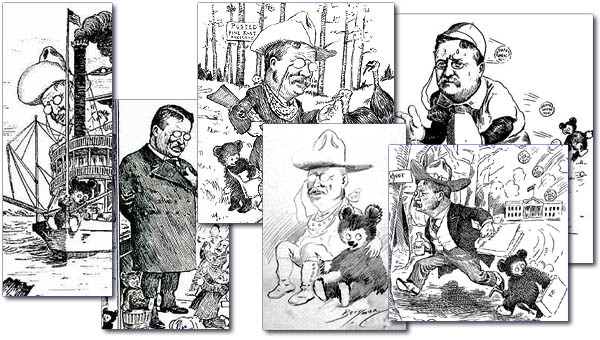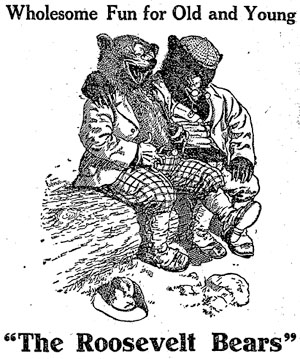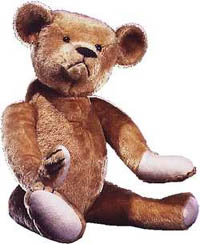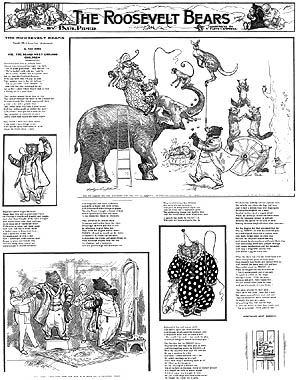|
The Teddy Bear[ This text is also available in Swedish ]
There are some slightly different versions of this story. In one (the correct one), the bear that got to live wasn't a cub but an adult that was tied to a tree. In another (less than true), the toy bears were a joke by the staff at the hotel were the hunters slept. In yet another, the bears were introduced at the wedding of Roosevelt's daughter. Never mind those urban legends, the hunting episode still appears to have quite little to do with the birth of the Teddy Bear. Still, both versions (cub and adult) appear to have some truth in them. Late in 1900 or early in 1901, Roosevelt (vice president at the time) captured a cub and gave it to the Bronx Zoo: About six months ago, when Vice President Roosevelt presented
the Bronx Park Zoo with a tiny black bear that he had caught alive on his last
mountain-lion hunt, the little fellow was a very well behaved youngster, very
shy, afraid that everything would eat him, much afraid of the other bears, more
afraid of Keeper Hoey, and most of all afraid of the crowds that surrounded the
bears' den and ogled him and pointed him out as the "real thing bear." [...]
New York Times, July 21, 1901 The famous episode took place in 1902. President Roosevelt was in Mississippi, trying to settle some border people didn't agree about. During a hunt, he refused to shoot a bear. (It appears the version with the adult bear tied to a tree is the correct one, but that is not the main topic here.) Anyway, cartoonist Clifford Berryman got the opportunity to make the cartoon above, with the clever headline "Drawing the line in Mississippi". The cartoon was published in the Washington Post on November 16, 1902. (Some sources mention the Washington Star, which is wrong - Berryman joined the Star in 1907.) Several sources claim the original cartoon featured an adult bear that was later modified into a cub for increased cuteness.
None of these bears were immortalized as toys. At least not the "Teddy Bear". What they did was to firmly associate Roosevelt with bears, especially since Berryman kept the cub as a presidential sidekick in his cartoons. In 1905, Seymour Campbell Eaton (using the pen-name Paul Piper in the newspaper) began writing (in verse) about two bears from Colorado, The Roosevelt Bears. They got their names, Teddy--B and Teddy--G (for "black" and "grey", and always with "--"), from stuff left by hunters - one can easily imagine who. In January 1906, the New York Times began publishing their first adventure, the voyage from Colorado to New York, in the sunday supplement, with nice illustrations by V. Floyd Campbell. (Compare the hat at the bears' feet with the one carried by Teddy in several of the cartoos above - a memory of his time as a Rough Rider in the Spanish-American war of 1898.)
The Roosevelt Bears became immensely popular. It was syndicated in 20 newspapers and ran for 29 weeks. That very year, two real bear cubs arrived at the Bronx Zoo.
Two cubs being more than twice as cute as a single one, from Colorado or not, they became as popular as their namesakes. It didn't take long for people to buy or make toy bears in pairs, their names being obvious. Many of the girls and women here [Asbury Park, a popular resort in
New Jersey] started a new fad to-night. More than twenty of them were on the boardwalk,
carrying miniature bears made of "ice wool," fuzzy, and as white as snow. [...]
New York Times, July 14, 1906 Though the toy business apparently didn't come up with the idea, they soon supplied the market with what it desired - possibly naming the popular Steiff jointed bears (and similar designs, which appear to be the technical definition of a Teddy Bear) after the famous Roosevelt Bears. After the two little bears - real live bears - arrived at the Zoological Park in Bronx and attracted such crowds of children to see them, some shrewd dealer in toys saw possibilities in the bear business. He had models made of Teddy-B and Teddy-G and sent them to Germany with an order for two or three thousand like them. From the moment the bears arrived here they sold like hotcakes. Now every steamer from Germany is bringing in fresh consignements of Roosevelt Bears, not only for the originator of the toy bears, but for others who have followed their example. New York Times, October 13, 1906 The Michtoms & Ideal Toy Company
According to innumeral sources, the Teddy Bear was created in 1902 or 1903, by Rose and Morris Michtom of Brooklyn, New York, an enterprise that eventually grew into Ideal Novelty and Toy Company/Ideal Toy Company. But the supposedly original Ideal bear (pictured above) was presented as a gift in 1963 by Benjamin Michtom to Kermit Roosevelt, Teddy's son, who in turn gave it to the Smitshonian. If it was indeed made in 1902-03, it wasn't marketed as a "Teddy Bear" at the time. The story of Mr. Michtom asking for Theodore's permission to use his name on the bear in 1902 simply doesn't fit in with the facts. As noted above, the jointed design was created by the Steiffs in about 1902 (it first appeared in a Leipzig fair in 1903), and the term "Teddy Bear" wasn't established until the fall of 1906. It thus appears the Michtoms neither came up with the design nor the name. Rather, they jumped on the bandwagon like many other manufacturers and importers - the claim that they created it is inaccurate. Another piece of unconfirmed information is that the republicans used bears as an inofficial symbol during the elections of 1904. If so, they would have far more to do with the Berryman cartoons than any toys. That the song The Teddy Bears' Picnic was used in 1904 is definitely false, since neither the music nor the lyrics had been written by then.
New York Times, December 16, 1906 The poem The Passing of the Doll describes the conflict between the dolls and the oh-so-popular bears. As you can see, it manages to establish the age of the bears as well as a (somewhat irrelevant) connection with Teddy R.
The bear above is dated to "circa 1903". Since it's obviously Teddy--B, it cannot be earlier than 1906 (providing the clothes are original).
Sources:
|










